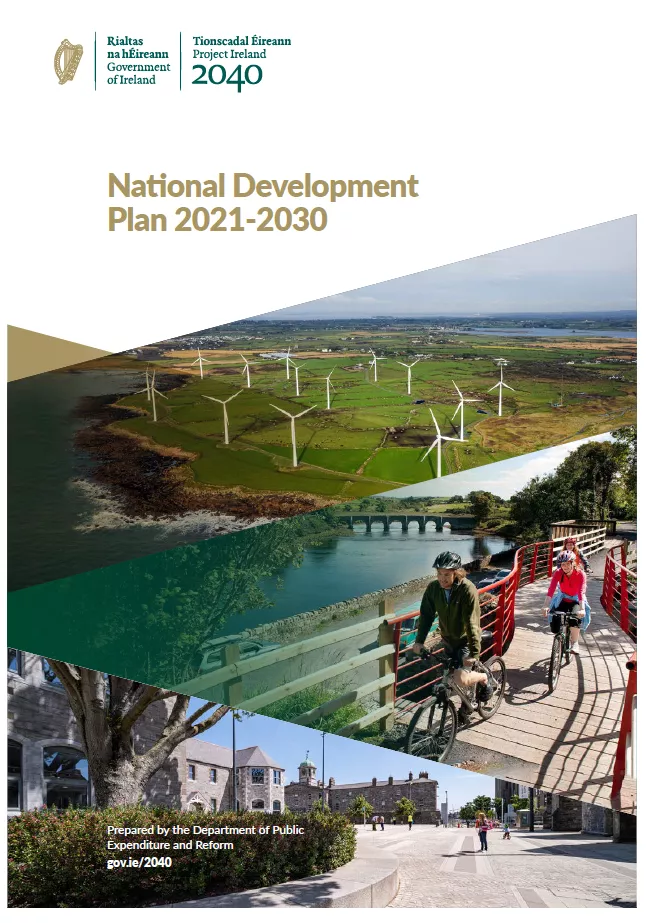
Ireland’s new National Development Plan
Ireland’s new National Development Plan
The CIOB’s response to the publication of Ireland’s new National Development Plan
A new iteration of Ireland’s National Development Plan 2021-2030 (NDP) was launched yesterday. The NDP outlines the largest capital investment plan in the history of the state - €165 billion - with a focus on housing, climate, transport, healthcare, regionally balanced job growth, and national economic renewal for the decade ahead. The CIOB gave evidence to ‘Review to Renew’ - the public consultation of the Review of the National Development Plan, and we are happy to see a number of our recommendations captured in the NDP.
Pipeline
The CIOB frequently emphasises the importance of a clear pipeline of projects to encourage the growth of the construction sector, to attract new entrants, and to mitigate the industry’s economic cyclicality. Our report ‘The Real Face of Construction 2020’, highlights the role that government, as a client, can play in subduing volatility in the construction sector by by smoothing out public spending on construction projects. The NDP commits to providing this pipeline, and the clarity it provides regarding the future of work will create an environment in which the construction sector is equipped to deliver on Ireland’s significant housing and infrastructure ambitions.
Climate
With building and construction accounting for 39% of all carbon emissions in the world, the environmental impact of the built environment is undeniable. We therefore welcome the centrality of climate change in the NDP, and the introduction of a methodology to assess the climate and environmental impact of every project that will be developed under the plan. While we recognise the need to continue to develop Ireland’s infrastructure, we agree that only projects that pass a rigorous climate and environmental impact assessment should proceed. This will ensure the credibility of the construction sector’s climate credentials.
Transport
Lockdowns over the last 18 months have shown tangible gains in terms of reduced carbon emissions, and cleaner air in cities and towns. All the indications are that the public want to preserve these gains. The built environment can lead on this by encouraging a move away from car-dependent development and facilitating sustainable transport infrastructure. We therefore welcome the proposed 2:1 spending ratio in favour of public transport over road building outlined in the NDP.
Space has been reclaimed for pedestrians and cyclists, with streets being pedestrianised and repurposed to create outdoor social spaces. Now that people have been given a glimpse of what it is like to live in towns and cities that prioritise sustainable transport infrastructure and the public realm, the Government has an opportunity to lead on enshrining these gains in policy. The public transport spending ratio in the NDP is a step in the right direction.
Retrofit
While the document frequently refers to a forthcoming National Retrofit Plan, we are disappointed not to see more attention given to retrofit in the NDP. With the residential sector responsible for 24% of energy related CO2 emissions in Ireland, and the importance the plan ostensibly places on climate change, it would have been opportune to embed a retrofit strategy within the NDP. Furthermore, given the interaction of housing with transport and infrastructure, the NDP could have been positioned as a wider strategy for the built environment, rather than treating each area in isolation, as seems to be the direction of travel.
Delivery
Indeed, recent weeks have seen a proliferation of new policy plans for the built environment. The NDP follows ‘Housing for All’, with the Climate Action Plan, and a National Residential Retrofit Strategy to be published in the coming weeks. There is a danger of these different strategies promulgating the siloed thinking that infamously affects government departments, leading to adverse policy outcomes for the built environment.
From a construction perspective the key question is how will these documents translate to projects on the ground? With a lot of construction firms still facing challenges around materials shortages; the availability of land and a shrinking labour force, each of these strategies will stand or fall on whether they address these issues and deliver on Ireland’s significant capital expenditures ambitions.
Contact our Press Office
We welcome requests for information, comments and interviews from journalists across the globe so please feel free to contact us: